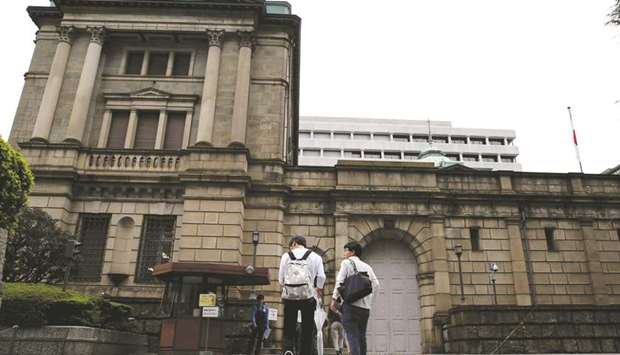The central bank spent ¥833bn ($7.8bn) on exchange-traded funds tracking the country’s shares last month, the biggest amount in data stretching back to late 2010. In the first quarter, too, it bought more than ever before. The BoJ stepped in as the market slumped in a global equity rout, deserted by foreign investors, with the benchmark Topix index sinking to its first back-to-back monthly declines since the start of 2016.
Haruhiko Kuroda’s bank is now ahead of schedule in its goal of spending about ¥6tn a year on ETFs. It used almost a third of its annual budget in just the first quarter. The central bank has been largely consistent in its purchasing habits, tending to buy on days the Topix falls in the morning. But that’s making some investors concerned about lessened firepower should the selloff continue.
“If the market keeps on falling, there will be the problem of what they do next,” said Kazuyuki Terao, chief investment officer for the Japan arm of Allianz Global Investors, which oversees $614bn globally.
The BoJ started buying ETFs in 2010, with governor Kuroda later accelerating purchases as part of an unprecedented stimulus package aimed at revitalising the economy. The central bank has spent $183bn on Japanese ETFs, with 30% of the purchases coming last year. It owned 74% of the market at the end of October, up from 65% a year earlier, according to Investment Trusts Association figures, BoJ disclosures and data compiled by Bloomberg.
Terao says he doesn’t see the BoJ increasing – or reducing – its purchase target for now, even as the Topix’s 6.1% decline in 2018 makes it one of the worst performers of 23 developed markets tracked by Bloomberg. The Nikkei 225 Stock Average of the country’s blue-chip shares fell more than 7% in February and March, closing the first quarter at 21,454.30.
“If it hadn’t been for the BoJ’s ETF buying, the Nikkei 225 would have breached 20,000,” said Ayako Sera, a market strategist at Sumitomo Mitsui Trust Bank in Tokyo. “For investors, March was a month to reduce exposure to Japanese equities.”
The BoJ bought ¥1.9tn in ETFs in the first quarter, which is 32% of its annual purchase goal. To be sure, Kuroda has said that the target isn’t set in stone at exactly ¥6tn per year, and annual purchases don’t necessarily have to be measured from January to December. On Tuesday, Kuroda said the central bank is discussing how to eventually exit from its massive monetary stimulus but that it’s still too early to reveal details.
Not that long ago, many investors expected the BoJ to join the global trend toward stimulus tapering by reducing ETF buying this year. That came after the Topix and the Nikkei 225 soared to their highest levels in a quarter century. But then the market slumped, and the situation changed.
Foreigners have muddied the picture, dumping Japanese equities as the yen gained to a 16-month high against the dollar.
They yanked almost ¥8tn from cash equities and futures in the first quarter alone, according to data through March 23. Suddenly, not many people are expecting a BoJ taper anytime soon.
Tatsuya Oguchi, chief executive officer and president of Franklin Templeton Investments in Japan, says the BoJ won’t rush to alter its ETF purchases.
“Obviously, the BoJ has to stop buying at some point,” Oguchi said. But “I think we have to wait until the Tokyo Olympics” in 2020, he said. “The BoJ won’t change their policy at least for another two three years.”
Kiyoshi Ishigane, chief strategist at Mitsubishi UFJ Kokusai Asset Management Co in Tokyo, agreed.
“Of course, they won’t cut back,” Ishigane said. Like the others, he doesn’t expect the bank to increase the target, either. “The BoJ would buy more if they could stop the market from falling, but it knows that it can’t.”



